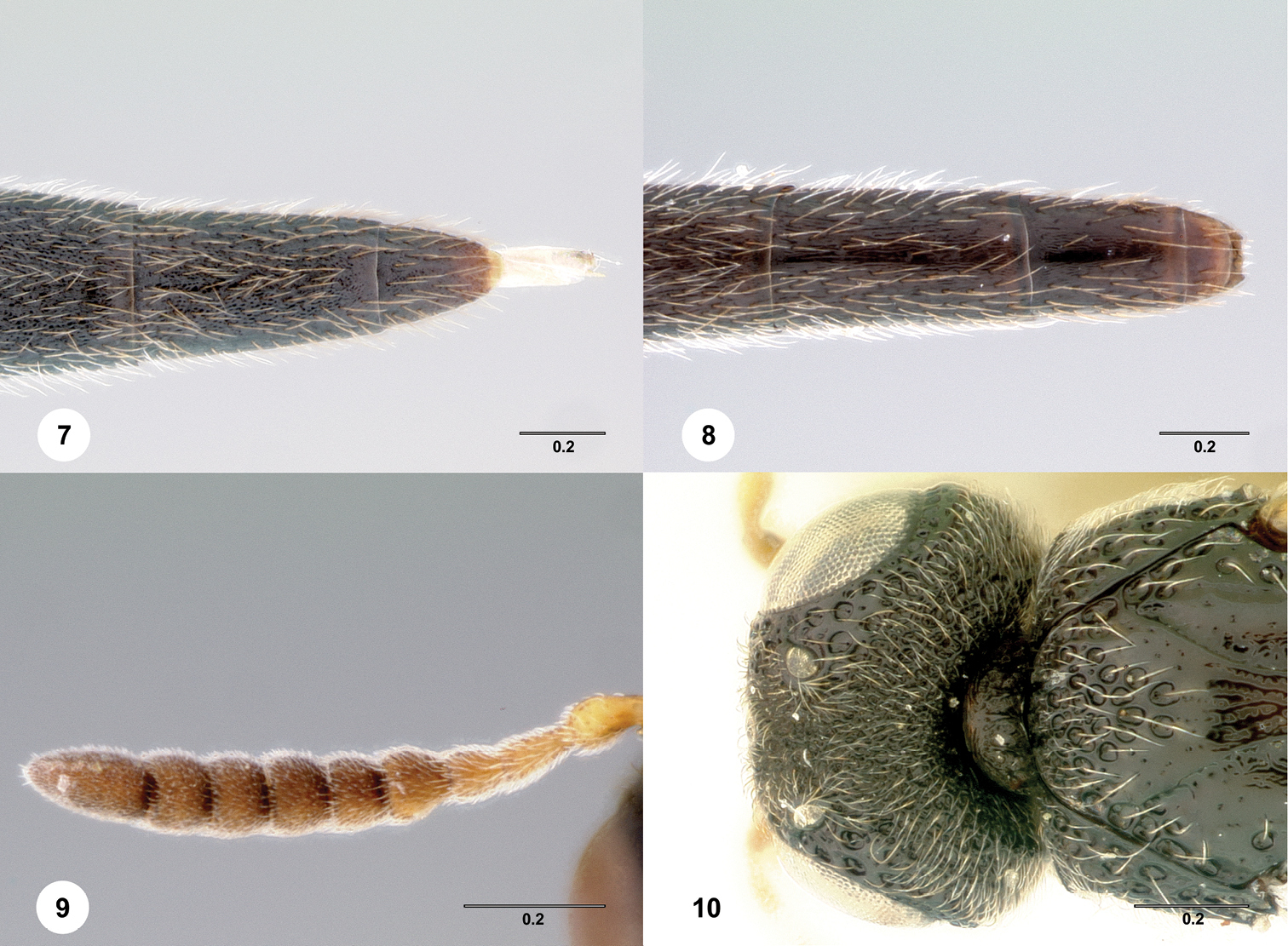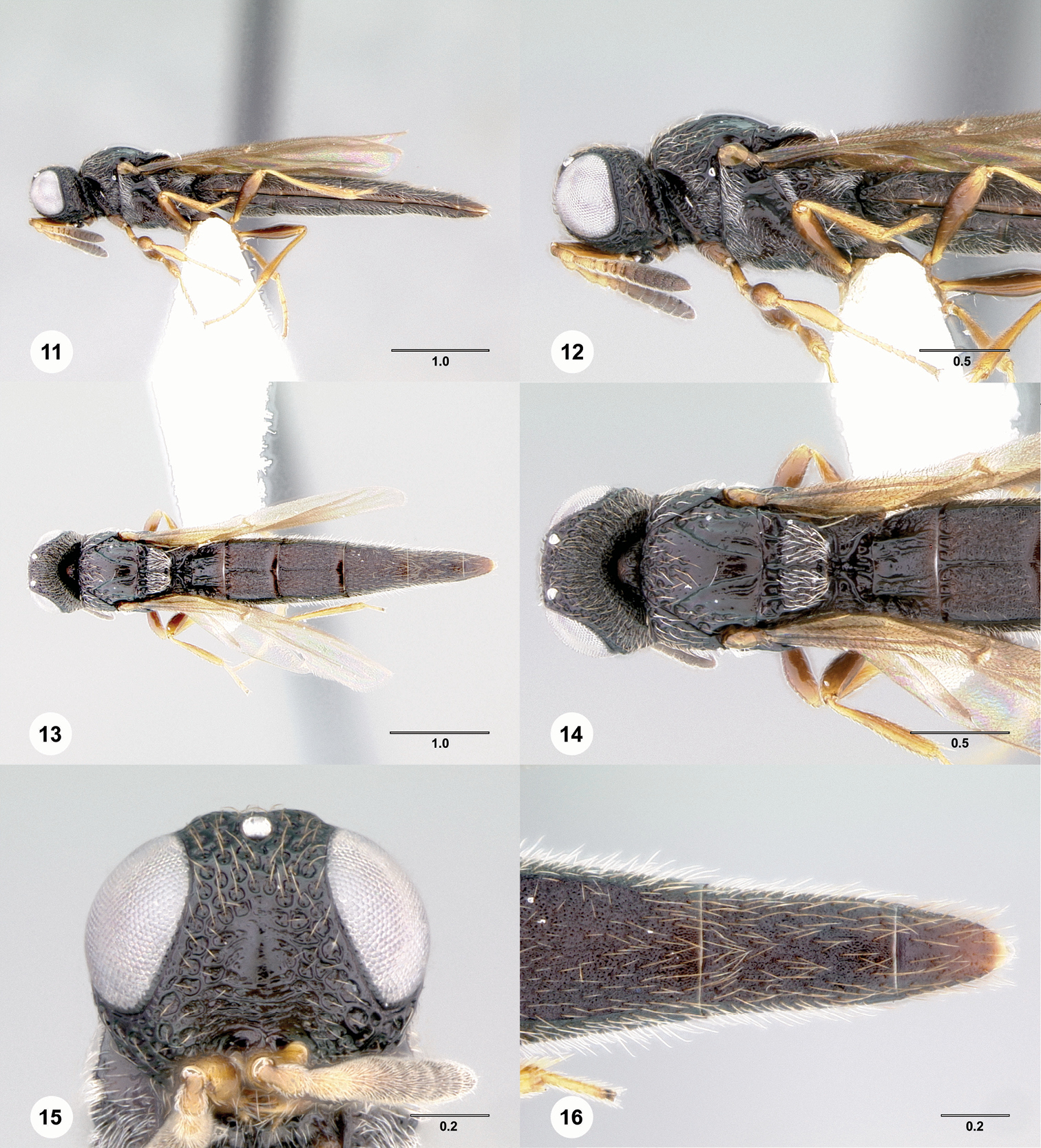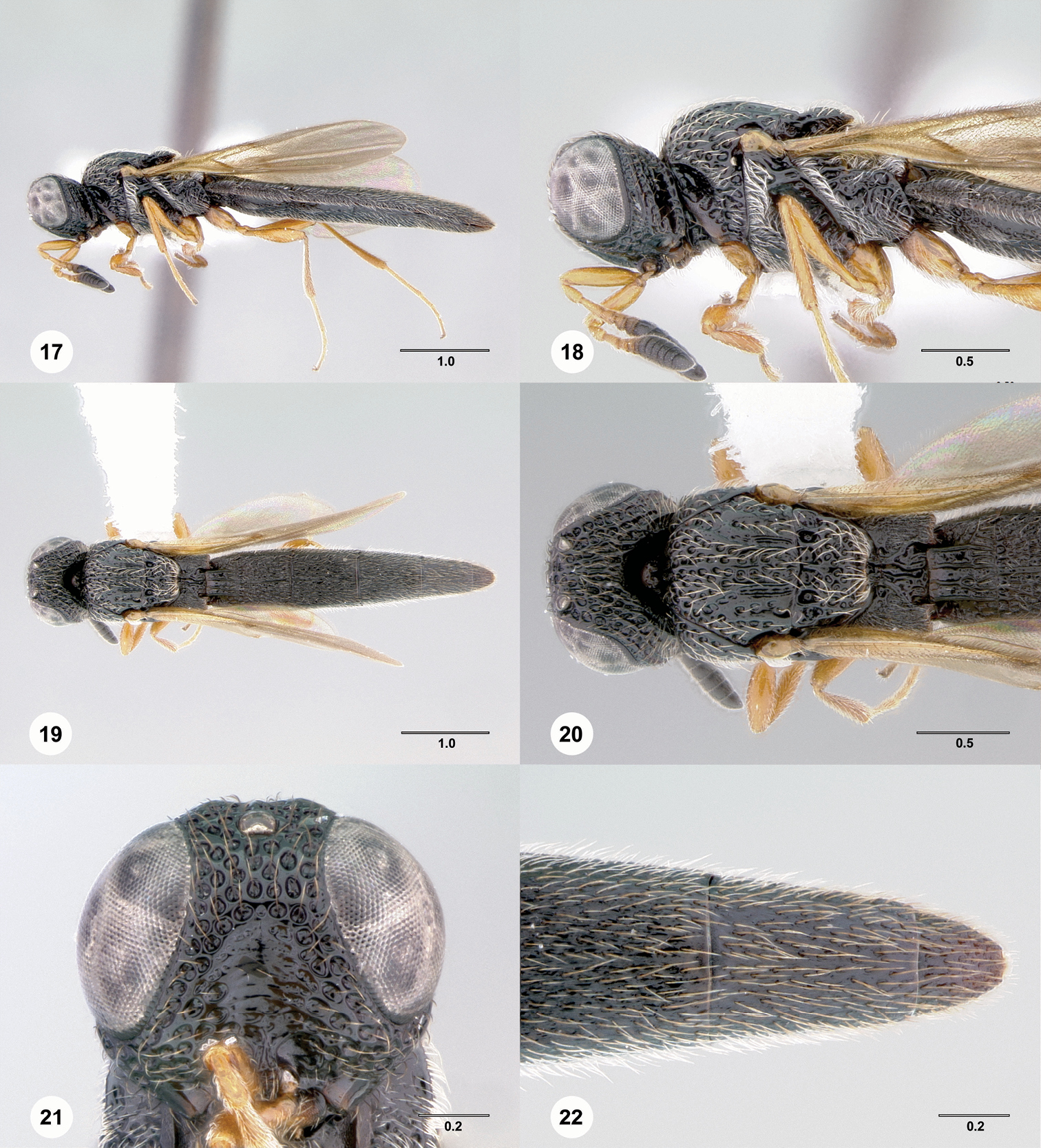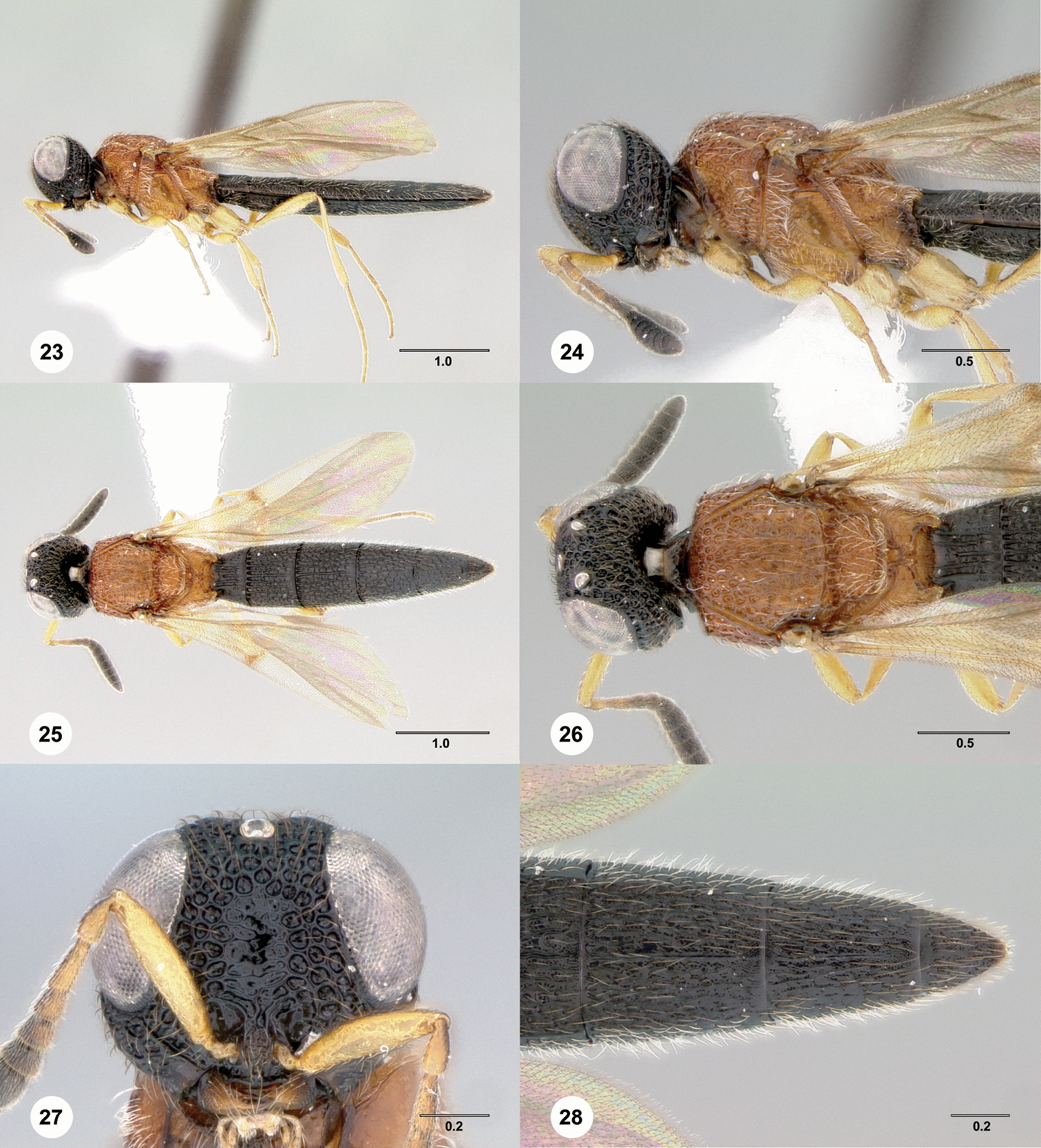






(C) 2011 Norman F. Johnson. This is an open access article distributed under the terms of the Creative Commons Attribution License, which permits unrestricted use, distribution, and reproduction in any medium, provided the original author and source are credited.
For reference, use of the paginated PDF or printed version of this article is recommended.
The genus Pseudoheptascelio Szabó is redescribed and its species revised. We recognize four species: Pseudoheptascelio muesebecki Szabó, Pseudoheptascelio cornopis Masner, Pseudoheptascelio tico sp. n. and Pseudoheptascelio rex sp. n. The genus is found from Guatemala south to the Brazilian state of Rio Grande do Sul. The species Pseudoheptascelio cornopis is recorded as a parasitoid of the eggs of Cornops aquaticum (Bruner) on water hyacinth, Eichhornia crassipes (Mart.) Solms.
Platygastridae, Platygastroidea, Scelioninae, egg-parasitoid, Cornops, key, biological control, water hyacinth, Eichhornia
The genus Pseudoheptascelio was described by
Pseudoheptascelio is found only in the New World tropics, from Belize and Guatemala south to southeastern Brazil. The distribution of the only known host, Cornops, is very similar, although its range extends north along the coasts of Mexico (
This work is based upon specimens in the following collections, with abbreviations used in the text: AEIC, American Entomological Institute, Gainesville, FL1; BMNH, The Natural History Museum, London, UK2; BPBM, Bernice P. Bishop Museum, Honolulu, HI3; CNCI, Canadian National Collection of Insects, Ottawa, Canada4; HNHM, Hungarian Natural History Museum, Budapest, Hungary5; MIZA, Museo del Instituto de Zoología Agrícola, Maracay, Venezuela6; OSUC, C.A. Triplehorn Insect Collection, Ohio State University, Columbus, OH7; TAMU, Texas A&M University Insect Collection, College Station, TX8; USNM, National Museum of Natural History, Washington, DC9.
Abbreviations and morphological terms used in text: A1, A2, ... A12: antennomere 1, 2, … 12; claval formula: distribution of the large, multiporous basiconic sensilla on the underside of apical antennomeres of the female, with the segment interval specified followed by the number of sensilla per segment (
Appendix 1 lists terms associated with identifiers in the Hymenoptera Anatomy Ontology (
In the Material Examined section the numbers prefixed with “OSUC” are unique identifiers for the individual specimens. The label data for all specimens have been georeferenced and recorded in the Hymenoptera On-Line database, and details on the data associated with these specimens can be accessed at the following link, hol.osu.edu, and entering the identifier in the form. Note the space between the acronym and the number.
Data associated with the genus Pseudoheptascelio can be accessed at http://hol.osu.edu/index.html?id=548. The generic and species descriptions were generated using a database application, vSysLab, designed to facilitate the production of a taxon by character data matrix, and to integrate those data with the existing taxonomic and specimen-level database. Data may be exported in both text format and as input files for other applications. The text output for descriptions is in the format of "Character: Character state (s)". Images and measurements were made using AutoMontage and Cartograph extended-focus software, using JVC KY-F75U digital camera, Leica Z16 APOA microscope, and 1X objectve lens. A standard set of images is provided for each species: dorsal habitus, lateral habitus, dorsal and lateral views of the head and mesosoma, and anterior view of head. Images are archived at Morphbank (www.morphbank.net) and in Specimage (specimage.osu.edu), the image database at The Ohio State University.
The electronic version of the paper contains hyperlinks to external resources. Insofar as possible, the external information conforms to standards developed and maintained through the organization Biodiversity Information Standards (Taxonomic Database Working Group). All new species have been prospectively registered with Zoobank (
This work is conducted as part of the Platygastroidea Planetary Biodiversity Inventory. The authors made equal contributions.
Taxonomyurn:lsid:zoobank.org:act:50643EC2-1EF4-496D-937B-8FBFDC9F9B8E
urn:lsid:biosci.ohio-state.edu:osuc_concepts:548
http://species-id.net/wiki/Pseudoheptascelio
Body length: 4.09–5.45 mm (n=81).
Head. Head shape in dorsal view: weakly transverse, width approximately 1.5× greatest length. Hyperoccipital carina: absent. Occipital carina: present laterally, broadly interrupted medially. Occipital carina sculpture: crenulate. OOL: lateral ocellus nearly contiguous with inner orbits, OOL < 0.5 OD. Upper portion of frons: convex, without frontal shelf. Scrobe shape: frons with shallow unmargined depression above toruli. Frons sculpture: areolate rugose, transversely striate within scrobe. Submedian carina: absent. Orbital carina: absent. Inner orbits: diverging ventrally. IOS/EH: IOS slightly less than EH. Interantennal process: rounded, strongly developed. Central keel: absent. Torulus opening: laterally on interantennal process. Lower frons striae: absent. Malar sulcus: present. Compound eye size: of normal proportions, not significantly reduced. Compound eye setation: sparsely setose. Gena: broad, convex, distinctly produced behind eye. Clypeus shape: transversely rectangular. Apical margin of clypeus: straight. Anteclypeus: present, delimited dorsally by raised carina. Postclypeus: present, strongly transverse. Labrum: not visible, hidden behind clypeus. Mandible shape: short, inconspicuous. Mandibular teeth: apex with 2, acute, subequal teeth. Arrangement of mandibular teeth: transverse. Number of maxillary palpomeres: 4. Shape of maxillary palpomeres: cylindrical. Number of labial palpomeres: 2.
Antenna. Number of antennomeres in female: 12. Number of antennomeres in male: 10. Insertion of radicle into A1: parallel to longitudinal axis of A1. Shape of A1: more or less cylindrical, not flattened. Length of A3 of female: distinctly longer than A2. Number of clavomeres in female antenna: 7. Claval formula of female antenna: A12–A7/1-2-2-2-2-2. Arrangement of doubled multiporous plate sensilla on female clava: in longitudinal pairs. Tyloid distribution on male antenna: A5 only. Shape of male flagellum: subclavate.
Mesosoma. Mesosoma shape in dorsal view: longer than wide. Mesosoma shape in lateral view: longer than high. Medial portion of transverse pronotal carina: weakly indicated laterally. Posterior apex of pronotum in dorsal view: straight, bifid apically to articulate with tegula. Vertical epomial carina: present. Dorsal epomial carina (corresponding to lateral portion of transverse pronotal carina of
Legs. Number of mid tibial spurs: 1. Number of hind tibial spurs: 1. Dorsal surface of hind coxa: smooth. Hind tibia shape: cylindrical, ecarinate. Trochantellus: indicated only as basal swelling of femur.
Wings. Wing development of female: macropterous. Wing development of male: macropterous. Tubular veins in fore wing: present. Bulla of fore wing R: absent. Extent of marginal venation of fore wing: R1 reaching and ending at costal margin. Origin of r-rs in fore wing: arising before (basad of) R/R1 attains costal margin. Development of basal vein (Rs+M) in fore wing: spectral. Development of R in hind wing: abbreviated, not attaining costal margin.
Metasoma. Number of externally visible terga in female: 6. Number of externally visible sterna in female: 6. Number of externally visible terga in male: 7. Number of externally visible sterna in male: 7. Shape of metasoma: lanceolate. Laterotergites: present, narrow. Laterosternites: present. T1 of female: raised medially into low, rectangular platform, laterally depressed. Relative size of metasomal tergites: T2–T4 largest, subequal in size. Terga with basal crenulae: T1–T3. Sublateral carinae on tergites: present on T1–T4. Median longitudinal carina on metasomal tergites: present T2–T3, variably extending beyond. Anterior margin of S1: protruding anteriorly as short sharp extension of median longitudinal carina of S1. Distribution of felt fields: present on S2, S3. Ovipositor type: Scelio-type (
Within the tribe Scelionini s. str. the genera Pseudoheptascelio, Scelio, Sceliocerdo, and Synoditella have 10-segmented antennae in the male. Pseudoheptascelio may be separated from the vast majority of these species by the presence of short, hooklike axillular projections on the mesoscutellum, the medially produced metascutellum, the densely setose anterior margins of both the mesopleuron and metapleuron (Figs 2, 12, 18, 24), the rigid unflexed metasoma (Figs 1, 11, 17, 23), well-developed notauli (Figs 4, 14, 20, 26), the absence of fanlike striae arising from the base of the mandible (Figs 6, 15, 21, 27), and the broadly interrupted occipital carina (Figs 4, 14, 20, 26). At least one Neotropical species of Scelio has axillular points and a projecting metascutellum. Pseudoheptascelio may be distinguished from this by the posteriorly declivous mesoscutellum, distinct notauli, the presence of dense pilosity on the anterior margins of the meso- and metapleuron, the subclavate male antenna (Fig. 9), the elongate T2–T6 (clearly longer than wide), and the smooth transition of the lateral margins of T5–T7 and subclavate antenna in the male (Fig. 8).
| 1 | T2–T3 reticulate (Figs 5, 13, 19), without distinct longitudinal rugulae; mesosoma black; T6 longer than wide basally | 2 |
| – | T2–T3 with distinct longitudinal rugulae (Fig. 25); mesosoma often with reddish portions (Figs 23–26); basal width of T6 greater than its length | 3 |
| 2 | Occiput without microsculpture within foveolae, appearing shining; length of T5 1.3–1.8 x its maximum width (Fig. 16) | Pseudoheptascelio muesebecki |
| – | Occiput with dense fine microsculpture within foveolae, appearing matte (Fig. 10); length of T5 1.6–2.2 x its maximum width (Fig. 7) | Pseudoheptascelio cornopis |
| 3 | Head and mesosoma without coriaceous microsculpture, appearing shining; metascutellum short, subquadrate (Fig. 20) | Pseudoheptascelio rex |
| – | Head and mesosoma with distinct superimposed coriaceous microsculpture, giving body overall matte appearance; metascutellum distinctly longer than wide (Fig. 26) | Pseudoheptascelio tico |
urn:lsid:zoobank.org:act:270062C9-88EC-4138-8ADF-284DF6B24F93
urn:lsid:biosci.ohio-state.edu:osuc_concepts:5132
http://species-id.net/wiki/Pseudoheptascelio_cornopis
Figures 1–10; Morphbank 10Body length of female: 4.37–5.45 mm (n=11). Body length of male: 4.58–5.22 mm (n=4). Mesosoma color: black. Body microsculpture pattern: smooth.
Rugae on occiput: reticulate. Microsculpture between occipital rugae: foveolate (Fig. 10). Setae on crests of occipital rugae: absent. Shape of female A4: length subequal to width. Shape of female A5: transverse. Shape of female A6: distinctly transverse.
Setation of pronotal depression: moderately to densely setose. Setation of netrion: moderately to densely setose (Fig. 2). Sculpture of midlobe of mesoscutum: foveate to areolate anteriorly, sculpture effaced, sparser posteriorly (Figs 4, 10). Number of trabecula across transscutal articulation: 7–8, widely spaced. Shape of metascutellum: short, shallowly cleft medially (Fig. 4). Sculpture of mesopleural depression: almost entirely sculptured, with transverse rugulae and interspersed irregular fovea.
Sculpture of T2–T3: irregularly reticulate, without longitudinal orientation. Length/width of female T5: 1.61–2.22 mm (n=12). Length/width of female T6: 1.10–1.50 mm (n=11). Sculpture of T6: with reticulate microsculpture only. Apex of male T7: pointed laterally, shallowly excavate or straight medially (Fig. 8).
30 Pseudoheptascelio cornopis (Masner), female (OSUC 186250) 1 Lateral habitus 2 Head and mesosoma, lateral view 3 Dorsal habitus 4 Head and mesosoma, dorsal view 5 Metasoma, dorsal view 6 Head, anterior view. Scale bars in millimeters.
31 Pseudoheptascelio cornopis (Masner) 1 Apex of metasoma, female, dorsal view (OSUC 186250) 2 Apex of metasoma, male (OSUC 248318) 3 Antenna, segments 2–10, male (OSUC 248318) 4, Head, dorsal view, holotype female (B.M. TYPE HYM. 9.772). Scale bars in millimeters.
Pseudoheptascelio cornopis is distinguished from Pseudoheptascelio muesebecki by the densely and finely sculptured vertex and the more elongate T5 (length/width 1.6–2.2).
Data from specimen labels: emerged from egg of Cornops Scudder: [Orthoptera: Acrididae]; solitary egg parasitoid of Cornops Scudder: [Orthoptera: Acrididae]; unspecified association Cornops frenatum (Marschall): [Orthoptera: Acrididae]; emerged from egg of Cornops longicorne (Brunner): [Orthoptera: Acrididae]; solitary egg parasitoid of Cornops longicorne (Brunner): [Orthoptera: Acrididae]; emerged from egg on Eichhornia crassipes (Mart.): [Liliales: Pontederiaceae]; solitary egg parasitoid ex Eichhornia crassipes (Mart.): [Liliales: Pontederiaceae]; unspecified association Eichhornia crassipes (Mart.): [Liliales: Pontederiaceae]
Holotype, female, Tanaoscelio cornopis: TRINIDAD AND TOBAGO: Trinidad Isl., Débé, V-1970, B.M. TYPE HYM. 9.772 (deposited in BMNH). Paratypes: TRINIDAD AND TOBAGO: 3 females, 1 male, 2 unknowns, BMNH(E)#790244–790245 (BMNH); OSUC 186160–186162 (CNCI); OSUC 248318 (USNM). Other material: (9 females, 2 males) BOLIVIA: 7 females, 1 male, OSUC 186242, 186245–186250, 186253 (CNCI). BRAZIL: 1 female, 1 male, OSUC 186241 (CNCI); OSUC 131887 (OSUC). GUYANA: 1 female, OSUC 215796 (BPBM). Allotype: TRINIDAD AND TOBAGO: 1 male, BMNH(E)#790243 (BMNH). VENEZUELA: 1 female, OSUC 221615 (MIZA).
In the brief key to species
urn:lsid:zoobank.org:act:E3EF612E-195C-45DD-86BA-14EB72125754
urn:lsid:biosci.ohio-state.edu:osuc_concepts:5133
http://species-id.net/wiki/Pseudoheptascelio_muesebecki
Figures 11–16; Morphbank 12Body length of female: 4.09–5.42 mm (n=15). Mesosoma color: black. Body microsculpture pattern: smooth.
Rugae on occiput: reticulate. Microsculpture between occipital rugae: absent. Setae on crests of occipital rugae: absent. Shape of female A4: length subequal to width. Shape of female A5: transverse. Shape of female A6: distinctly transverse.
Setation of pronotal depression: moderately to densely setose (Fig. 12). Setation of netrion: moderately to densely setose. Sculpture of midlobe of mesoscutum: foveate to areolate throughout; foveate to areolate anteriorly, or sculpture effaced, sparser posteriorly (Fig. 14). Number of trabecula across transscutal articulation: 7–8, widely spaced. Shape of metascutellum: short, shallowly cleft medially (Fig. 14). Sculpture of mesopleural depression: almost entirely sculptured, with transverse rugulae and interspersed irregular fovea.
Sculpture of T2–T3: irregularly reticulate, without longitudinal orientation. Length/width of female T5: 1.26–1.80 mm (n=15). Length/width of female T6: 1.05–1.53 mm (n=15). Sculpture of T6: with reticulate microsculpture only.
32 Pseudoheptascelio muesebecki Szabó, female (OSUC 186208) 11 Lateral habitus 12 Head and mesosoma, lateral view 13 Dorsal habitus 14 Head and mesosoma, dorsal view 15 Head, anterior view 16 Apex of metasoma, dorsal view. Scale bars in millimeters.
This species is very similar to Pseudoheptascelio cornopis, and it may be distinguished by the less elongate T5 and the coarse areolate sculpture on the vertex.
No data available.
Holotype, female: BRAZIL: PA, Belém, no date, E. Horváth, HNHM 0015 (deposited in HNHM). Other material: (14 females) BOLIVIA: 1 female, OSUC 186244 (CNCI). BRAZIL: 9 females, OSUC 186233–186240 (CNCI); OSUC 58878 (OSUC). ECUADOR: 1 female, OSUC 186208 (CNCI). PARAGUAY: 2 females, OSUC 176024, 176033 (OSUC). TRINIDAD AND TOBAGO: 1 female, OSUC 186163 (CNCI).
urn:lsid:zoobank.org:act:32540FD3-5763-4536-BD1A-A50849D8A6D6
urn:lsid:biosci.ohio-state.edu:osuc_concepts:242983
http://species-id.net/wiki/Pseudoheptascelio_rex
Figures 17–22; Morphbank 14Body length of female: 4.13–5.26 mm (n=20). Body length of male: 4.50–5.16 mm (n=13). Mesosoma color: black; red brown at least dorsally, otherwise dark to brown black. Body microsculpture pattern: smooth.
Rugae on occiput: longitudinal. Microsculpture between occipital rugae: absent. Setae on crests of occipital rugae: present. Shape of female A4: length subequal to width; length distinctly greater than width. Shape of female A5: transverse; subquadrate. Shape of female A6: distinctly transverse; weakly transverse.
Setation of pronotal depression: glabrous or sparsely setose. Setation of netrion: moderately to densely setose. Sculpture of midlobe of mesoscutum: foveate to areolate throughout (Fig. 20). Number of trabecula across transscutal articulation: 7–8, widely spaced. Shape of metascutellum: short, shallowly cleft medially (Fig. 20). Sculpture of mesopleural depression: foveolate anteriorly, transversely rugulose ventrally, with large smooth area dorsally surrounding mesopleural pit.
Sculpture of T2–T3: reticulate, with distinct longitudinal orientation. Length/width of female T5: 0.89–1.72 mm (n=20). Length/width of female T6: 0.81–1.26 mm (n=20). Sculpture of T6: with shallow foveolae impressed on reticulate background microsculpture. Apex of male T7: pointed laterally, shallowly excavate or straight medially.
33 Pseudoheptascelio rex, sp. n., holotype female (OSUC 186230) 17 Lateral habitus 18 Head and mesosoma, lateral view 19 Dorsal habitus 20 Head and mesosoma, dorsal view 21 Head, anterior view 22 Apex of metasoma, dorsal view. Scale bars in millimeters.
This species shares the short female T6 (Fig. 22) and, in many specimens, the red mesosoma with Pseudoheptascelio tico. It may be distinguished by the short metascutellum (Fig. 20) and the absence of coriaceous microsculpture on the head and mesosoma.
The specific epithet is Latin for king and should be treated as a noun in apposition.
Data from specimen labels: collected on Trichocentrum panamensis Rolfe: [Orchidales: Orchidaceae]
Holotype, female: ECUADOR: Sucumbíos Prov., Sacha Lodge, 00°30'S, 76°30'W, 270m, 27.VIII–10.IX.1995, malaise trap, P. Hibbs, OSUC 186230 (deposited in CNCI). Paratypes: (49 females, 14 males) BOLIVIA: 6 females, 1 male, OSUC 186251–186252, 186254–186258 (CNCI). COLOMBIA: 10 females, 2 males, OSUC 287928 (CNCI); OSUC 210338–210341 (FSCA); OSUC 144252–144253, 189092, 191363, 193964, 210336, 224326 (OSUC). COSTA RICA: 2 females, OSUC 186186, 186194 (CNCI). ECUADOR: 19 females, 9 males, OSUC 186203–186207, 186209–186229, 186231 (CNCI); OSUC 58879 (OSUC). FRENCH GUIANA: 2 females, OSUC 186202, 287926 (CNCI). GUYANA: 1 male, OSUC 215795 (BPBM). NICARAGUA: 1 male, OSUC 320737 (TAMU). PANAMA: 9 females, OSUC 186199–186200 (CNCI); OSUC 248311–248317 (USNM). PERU: 1 female, OSUC 186232 (CNCI).
urn:lsid:zoobank.org:act:23DBB9A2-4F23-4F7E-AFC8-38A2906EE95E
urn:lsid:biosci.ohio-state.edu:osuc_concepts:242982
http://species-id.net/wiki/Pseudoheptascelio_tico
Figures 23–28; Morphbank 16Body length of female: 4.44–5.14 mm (n=12). Body length of male: 4.42–4.85 mm (n=5). Mesosoma color: red brown at least dorsally, otherwise dark to brown black. Body microsculpture pattern: with widespread superimposed coriaceous microsculpture.
Rugae on occiput: reticulate. Microsculpture between occipital rugae: absent. Setae on crests of occipital rugae: absent. Shape of female A4: length distinctly greater than width. Shape of female A5: subquadrate. Shape of female A6: weakly transverse.
Setation of pronotal depression: glabrous or sparsely setose (Fig. 24). Setation of netrion: glabrous or sparsely setose. Sculpture of midlobe of mesoscutum: foveate to areolate throughout (Fig. 26). Number of trabecula across transscutal articulation: 9–11, closely spaced. Shape of metascutellum: distinctly elongate, deeply cleft medially. Sculpture of mesopleural depression: irregularly foveolate, transverse rugulae very weakly indicated.
Sculpture of T2–T3: reticulate, with distinct longitudinal orientation. Length/width of female T5: 0.97–1.16 mm (n=13). Length/width of female T6: 0.93–1.13 mm (n=13). Sculpture of T6: with shallow foveolae impressed on reticulate background microsculpture. Apex of male T7: weakly pointed laterally, distinctly sinuous medially.
34 Pseudoheptascelio tico, n.sp., holotype female (OSUC 186191) 23 Lateral habitus 24 Head and mesosoma, lateral view 25 Dorsal habitus 26 Head and mesosoma, dorsal view 27 Head, anterior view 28 Apex of metasoma, dorsal view. Scale bars in millimeters.
This species should only be confused with red specimens of Pseudoheptascelio rex. It may be distinguished by the well-developed coriaceous microsculpture on the head and mesosoma, and the elongate, deeply cleft metascutellum (Fig. 26).
The specific epithet is a colloquial term for a Costa Rican, reflecting the origin of most of the specimens we have seen. It should be treated as a noun in apposition.
No data available.
Holotype, female: COSTA RICA: Alajuela Prov., creekbed, San Ramón Biological Station, 700m, 24.III–26.III.1996, yellow pan trap, L. Masner, OSUC 186191 (deposited in CNCI). Paratypes: (12 females, 5 males) BELIZE: 1 female, OSUC 287927 (USNM). COSTA RICA: 9 females, 5 males, OSUC 186181–186185, 186187–186190, 186192, 186195–186198 (CNCI). GUATEMALA: 1 female, OSUC 186268 (AEIC). PANAMA: 1 female, OSUC 186201 (CNCI).
Our thanks to Lubomír Masner for discussion, insight, and inspration; to A. Bennett, M. Buffington, S. Csősz, J.-L. García, S. Myers, D. Notton, T. Nuhn, J. Oswald, A. Polaszek, M. Sharkey, and D. Wahl for loans of specimens for study; and to J. Cora and S. Hemly for valuable logistical support. This material is based upon work supported in part by the National Science Foundation under grant No. DEB–0614764 to N.F. Johnson and A.D. Austin.
1 http://biocol.org/urn:lsid:biocol.org:col:1008
2 http://biocol.org/urn:lsid:biocol.org:col:1009
3 http://biocol.org/urn:lsid:biocol.org:col:1010
4 http://biocol.org/urn:lsid:biocol.org:col:1012
5 http://biocol.org/urn:lsid:biocol.org:col:33453
6 http://biocol.org/urn:lsid:biocol.org:col:33834
7 http://biocol.org/urn:lsid:biocol.org:col:1014
8 http://biocol.org/urn:lsid:biocol.org:col:34336
9 http://biocol.org/urn:lsid:biocol.org:col:1019
10 http://www.morphbank.net/?id=644094
11 http://hol.osu.edu/map-full.html?id=5132
12 http://www.morphbank.net/?id=644091
13 http://hol.osu.edu/map-full.html?id=5133
14 http://www.morphbank.net/?id=644092
15 http://hol.osu.edu/map-full.html?id=242983
16 http://www.morphbank.net/?id=644093
17 http://hol.osu.edu/map-full.html?id=242982
18 http://lsid.tdwg.org/urn:lsid:biosci.ohio-state.edu:osuc_pubs:20940
19 http://lsid.tdwg.org/urn:lsid:biosci.ohio-state.edu:osuc_pubs:131
20 http://lsid.tdwg.org/urn:lsid:biosci.ohio-state.edu:osuc_pubs:235
21 http://lsid.tdwg.org/urn:lsid:biosci.ohio-state.edu:osuc_pubs:229
22 http://lsid.tdwg.org/urn:lsid:biosci.ohio-state.edu:osuc_pubs:21243
23 http://lsid.tdwg.org/urn:lsid:biosci.ohio-state.edu:osuc_pubs:998
24 http://lsid.tdwg.org/urn:lsid:biosci.ohio-state.edu:osuc_pubs:311
25 http://lsid.tdwg.org/urn:lsid:biosci.ohio-state.edu:osuc_pubs:474
26 http://lsid.tdwg.org/urn:lsid:biosci.ohio-state.edu:osuc_pubs:21300
27 http://lsid.tdwg.org/urn:lsid:biosci.ohio-state.edu:osuc_pubs:23221
28 http://lsid.tdwg.org/urn:lsid:biosci.ohio-state.edu:osuc_pubs:452
29 doi:10.1371/journal.pone.0015991
30 http://www.morphbank.net/?id=644067
31 http://www.morphbank.net/?id=644072
32 http://www.morphbank.net/?id=644091
Correspondence between anatomical terms used and the Hymenoptera Anatomy Ontology. Identifiers may be resolved by appending them to the following URL: http://purl.obolibrary.org/obo/
| A1 | HAO_0000908 |
| A2 | HAO_0000706 |
| A3 | HAO_0001148 |
| A7 | HAO_0001885 |
| A12 | HAO_0001884 |
| acetabular carina | HAO_0000292 |
| admedian line | HAO_0000128 |
| anteclypeus | HAO_0000209 |
| antenna | HAO_0000101 |
| antennomere | HAO_0000107 |
| anterior margin of clypeus | HAO_0001767 |
| area | HAO_0000146 |
| articulation | HAO_0001485 |
| axillula | HAO_0000160 |
| basal vein | HAO_0000170 |
| body | HAO_0000182 |
| bulla | HAO_0000184 |
| carina | HAO_0000188 |
| central keel | HAO_0000109 |
| clava | HAO_0001185 |
| clavomere | HAO_0001186 |
| clypeus | HAO_0000212 |
| compound eye | HAO_0000217 |
| corner | HAO_0000223 |
| coxa | HAO_0000228 |
| depression | HAO_0000241 |
| egg | HAO_0000286 |
| epomial carina | HAO_0000307 |
| eye | HAO_0000217 |
| felt field | HAO_0000322 |
| femur | HAO_0000327 |
| flagellum | HAO_0000343 |
| fore wing | HAO_0000351 |
| fovea | HAO_0000241 |
| frons | HAO_0001523 |
| frontal shelf | HAO_0001886 |
| gena | HAO_0000371 |
| head | HAO_0000397 |
| hind coxa | HAO_0000587 |
| hind tibia | HAO_0000631 |
| hind tibial spur | HAO_0001121 |
| hind wing | HAO_0000400 |
| hyperoccipital carina | HAO_0000406 |
| inner orbit | HAO_0000419 |
| interantennal process | HAO_0000422 |
| labrum | HAO_0000456 |
| lateral face of pronotum | HAO_0000483 |
| lateral ocellus | HAO_0000481 |
| laterotergite | HAO_0000493 |
| laterosternite | HAO_0001838 |
| line | HAO_0001586 |
| lower frons striae | HAO_0001770 |
| malar sulcus | HAO_0000504 |
| mandible | HAO_0000506 |
| mandibular tooth | HAO_0001019 |
| margin | HAO_0000510 |
| median longitudinal carina of S1 | HAO_0001878 |
| median longitudinal carina on metasomal tergite | HAO_0001878 |
| median longitudinal carina of mesoscutellum | HAO_0001878 |
| mesopleural carina | HAO_0000559 |
| mesopleural pit | HAO_00001358 |
| mesopleuron | HAO_0000566 |
| mesoscutellum | HAO_0000574 |
| mesoscutum | HAO_0001490 |
| mesosoma | HAO_0000576 |
| metapleuron | HAO_0000621 |
| metapostnotum | HAO_0000622 |
| metascutellum | HAO_0000625 |
| metasoma | HAO_0000626 |
| metasomal depression of propodeum | HAO_0000627 |
| mid coxa | HAO_0000635 |
| mid tibial spur | HAO_0001120 |
| midlobe of mesoscutum | HAO_0000520 |
| multiporous plate sensillum | HAO_0000640 |
| netrion | HAO_0000644 |
| notauli (notaulus) | HAO_0000647 |
| occipital carina | HAO_0000653 |
| occiput | HAO_0000658 |
| ocellus | HAO_0000661 |
| ocular ocellar line | HAO_0000662 |
| orbit | HAO_0000672 |
| orbital carina | HAO_0000810 |
| ovipositor | HAO_0000679 |
| palpomere | HAO_0001866 |
| pit | HAO_0000718 |
| parapsidal line | HAO_0000694 |
| postclypeus | HAO_0000743 |
| propodeal lateral projection | HAO_0000763 |
| process | HAO_0000822 |
| projection | HAO_0000829 |
| pronotum | HAO_0000853 |
| propodeum | HAO_0001248 |
| radial vein | HAO_0000888 |
| radicle | HAO_0000889 |
| scrobe | HAO_0000911 |
| sculpture | HAO_0000913 |
| segment | HAO_0000929 |
| skaphion | HAO_0000940 |
| sternaulus | HAO_0001205 |
| sternite | HAO_0001654 |
| submedian carina | HAO_0000973 |
| sulcus | HAO_0000978 |
| tegula | HAO_0000993 |
| tergite | HAO_0001783 |
| tibia | HAO_0001017 |
| torulus | HAO_0001022 |
| transscutal articulation | HAO_0001623 |
| transverse pronotal carina | HAO_0001031 |
| trochantellus | HAO_0001033 |
| tyloid | HAO_0001199 |
| vein | HAO_0001095 |
| venation | HAO_0001096 |
| vertex | HAO_0001077 |
| vertical epomial carina | HAO_0000307 |
| wing | HAO_0001089 |




